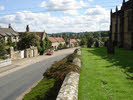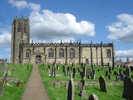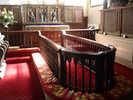

 Coxwold is a small attractive village on the south-western edge of the North York Moors, sitting just inside the boundaries of the National Park. Coxwold is built around a crossroads, with Thirsk Bank running from west to east and Husthwaite Road from north to south. Thirsk Bank climbs up quite steeply as it heads west, with the impressive village church half way up the climb and Shandy Hall, the home of Laurence Sterne (the author of Tristram Shandy), at the western end.
Coxwold is a small attractive village on the south-western edge of the North York Moors, sitting just inside the boundaries of the National Park. Coxwold is built around a crossroads, with Thirsk Bank running from west to east and Husthwaite Road from north to south. Thirsk Bank climbs up quite steeply as it heads west, with the impressive village church half way up the climb and Shandy Hall, the home of Laurence Sterne (the author of Tristram Shandy), at the western end.
Sterne had already published two of the nine volumes of Tristram Shandy in 1759, before his association with Coxwold began. He was made perpetual curate of Coxwold by Baron Fauconberg in 1760 as a reward for the quality of the book, and held the post for the remaining years of his life (he died in London in 1768. Sterne wouldn’t have been the active vicar of Coxwold, having already given up his clerical career to concentrate on his writing, but he spent some of his time in Coxwold and wrote the remaining seven volumes of Tristram Shandy and Sentimental Journey while he was at Coxwold.
St. Michael's Church is an impressive building, with an unusual octagonal tower and a tongue-shaped communion rail designed to fit into a narrow gap between memorials. The current building dates back to 1420 and replaced a much older church.
 The older part of the village lies on Thirsk Bank. For some time this was the main road between Malton and Thirsk, and the village was also served by the Thirsk and Malton Branch Line of the North Eastern Railway. Times have changed - the railway has gone and all of the roads to the village are quiet country lanes. Many of the houses on this street still have long 'garths', originally used for productive small-scale agriculture.
The older part of the village lies on Thirsk Bank. For some time this was the main road between Malton and Thirsk, and the village was also served by the Thirsk and Malton Branch Line of the North Eastern Railway. Times have changed - the railway has gone and all of the roads to the village are quiet country lanes. Many of the houses on this street still have long 'garths', originally used for productive small-scale agriculture.
There is a car park behind the village hall at the northern end of the village.
 Newburgh Priory is just to the south-east of the village. This is the home of the Faucomberg family, and according the legend Oliver Cromwell is buried there.
Newburgh Priory is just to the south-east of the village. This is the home of the Faucomberg family, and according the legend Oliver Cromwell is buried there.
The ruins of Byland Abbey are a short distance north of the village along Husthwaite Road, on the way to the hamlet of Wass. This was the final home of an abbey that was founded in 1135 and moved five times before reaching Byland in 1177. By this time it had become a Cistercian abbey, having been founded by the Savigniac order. The abbey eventually prospered and the ruins are still impressive.
Grid Reference: SE 535 771